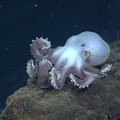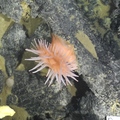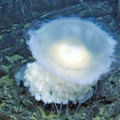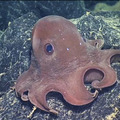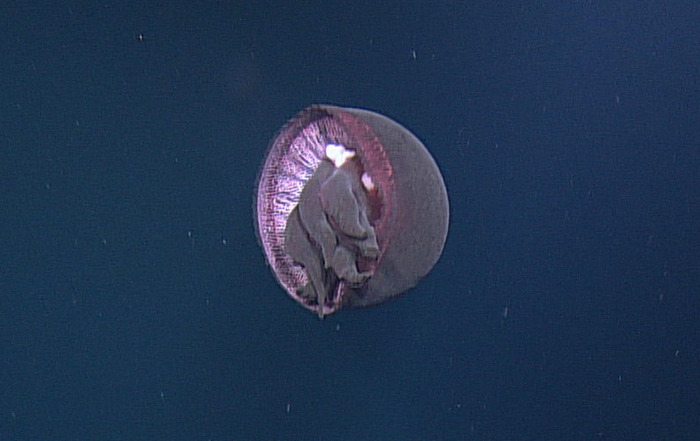Jellyfish belong to Class Scyphozoa (Phylum Cnidaria) and are quite common at Axial. Several have been photographed and videotaped, however, only a few have been identified to date.
Big Red Jelly (Tiburonia granrojo)
 Tiburonia granrojo, also known as the Big Red Jelly, is a unique species of jellyfish found in the eastern and northeastern Pacific Ocean. Unlike most jellyfish, it has thick, fleshy arms hanging beneath its main body, instead of tentacles. In addition, it can grow to enormous size, with the largest specimens reported at around 3 meters in diameter. As the name would suggest, T. granrojo is distinct for its deep, opaque red coloration.
Tiburonia granrojo, also known as the Big Red Jelly, is a unique species of jellyfish found in the eastern and northeastern Pacific Ocean. Unlike most jellyfish, it has thick, fleshy arms hanging beneath its main body, instead of tentacles. In addition, it can grow to enormous size, with the largest specimens reported at around 3 meters in diameter. As the name would suggest, T. granrojo is distinct for its deep, opaque red coloration.
Big Red is often seen hovering in the water above and around Axial, usually between 300 and 1000 meters deep in the mesopelagic zone. To date, the largest specimen observed is less than 50 cm in diameter.
References:
http://en.wikipedia.org/wiki/Tiburonia_granrojo
http://eol.org/pages/203504/details
Dinner Plate Jelly (Solmissus sp.)
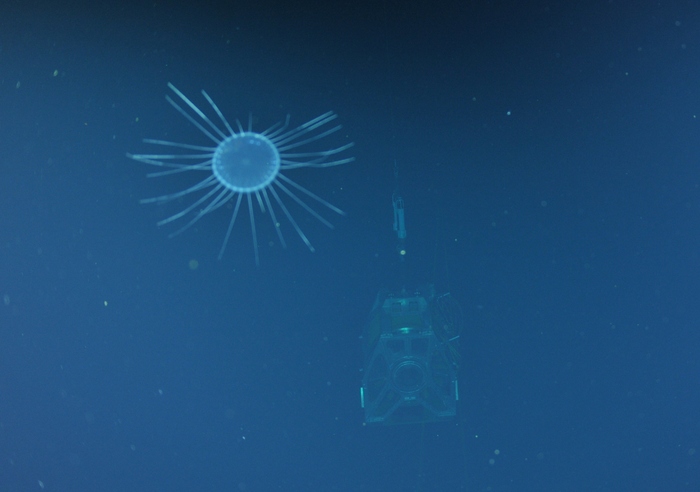 The Dinner Plate Jelly belongs to the Genus Solmissus, and derives its common name from its flat-shaped bell. Translucent white in color, they often are seen swimming with some tentacles pointing upward. They are known for actively hunting their prey, which is generally gelatinous organisms such as ctenophores and other jellyfish. Dinner Plate Jellies are a common sight in the deeper waters above Axial Seamount. They can grow to be 20 cm (8 in) in diameter.
The Dinner Plate Jelly belongs to the Genus Solmissus, and derives its common name from its flat-shaped bell. Translucent white in color, they often are seen swimming with some tentacles pointing upward. They are known for actively hunting their prey, which is generally gelatinous organisms such as ctenophores and other jellyfish. Dinner Plate Jellies are a common sight in the deeper waters above Axial Seamount. They can grow to be 20 cm (8 in) in diameter.
References:
http://jellieszone.com/hydromedusae/
http://www.imbc.gr/biblio_serv/deepsea/X4-0007.html
http://emeralddiving.com/id_jellyfish.html
Fried Egg Jelly (Phacellophora cantschatica)
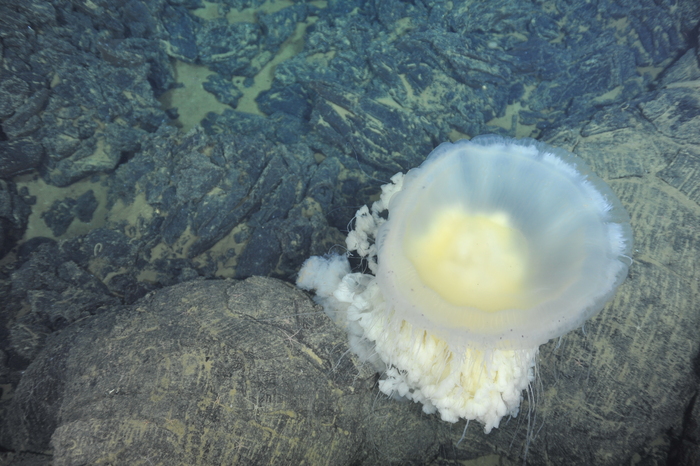 The Fried Egg Jellyfish is a large jelly, normally found drifting in the upper portions of the ocean. The central mass of tentacles and gonads is yellowish in color, and surrounded by a pale white bell. This resemblance to an egg is where these creatures get their common name. This species can have a bell 60 cm (2 ft) in diameter and tentacles reaching 6 m (20 ft) in length.
The Fried Egg Jellyfish is a large jelly, normally found drifting in the upper portions of the ocean. The central mass of tentacles and gonads is yellowish in color, and surrounded by a pale white bell. This resemblance to an egg is where these creatures get their common name. This species can have a bell 60 cm (2 ft) in diameter and tentacles reaching 6 m (20 ft) in length.
Its preferred foods are gelatinous creatures, particularly other jellyfish, which it catches in its long tentacles. This species’ sting is mild, and as a result, small and larval crustaceans have been known to hitch rides on its bell and even take food from its tentacles.
Fried Egg Jellyfish are normally seen in the pelagic region of the ocean. At Axial Seamount they have been imaged near to and on the seafloor, shortly before becoming a crab buffet.
References:
http://jellieszone.com/phacellophora.htm
http://www.wallawalla.edu/academics/departments/biology/rosario/inverts/Cnidaria/Class-Scyphozoa/Order-Semaeostomeae/Family-Ulmaridae/Phacellophora_camtschatica.html
Poralia rufescens
 Very little is known about this jellyfish, except that it lives in deep waters. It was previously spotted in the Atlantic Ocean at Lost City, and in the Pacific Ocean off the coast of Washington State and Canada at the site for the RSN underwater observatory. It is a flat disc, with eight tentacles in the center, and thin, wispy appendages around the outside of the disk. When it moves, it can undulate from flat to dome-shaped. It is red or pink in color, sometimes appearing brown from a distance.
Very little is known about this jellyfish, except that it lives in deep waters. It was previously spotted in the Atlantic Ocean at Lost City, and in the Pacific Ocean off the coast of Washington State and Canada at the site for the RSN underwater observatory. It is a flat disc, with eight tentacles in the center, and thin, wispy appendages around the outside of the disk. When it moves, it can undulate from flat to dome-shaped. It is red or pink in color, sometimes appearing brown from a distance.
References
http://oceanexplorer.noaa.gov/explorations/05lostcity/logs/july27/july27.html
http://species-identification.org/species.php?species_group=zsao&id=2438
Deepstaria enigmatica
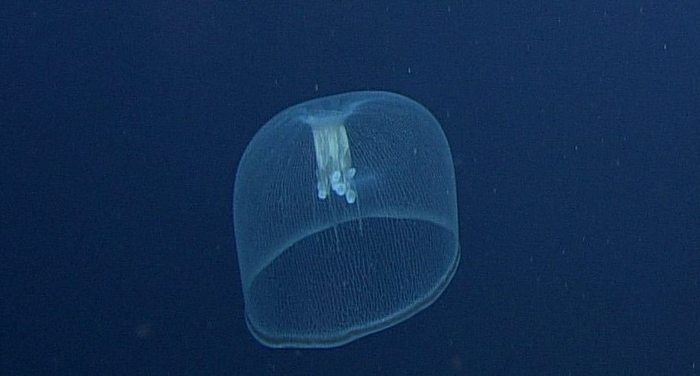 The Deepstaria enigmatica, observed over Axial Seamount, is translucent and resembles a lampshade. This specimen was approximately 30 cm in diameter, but they are known to reach up to 60 cm. Although they are not considered rare, it is hard to find a live one to study because of their size and fragility.
The Deepstaria enigmatica, observed over Axial Seamount, is translucent and resembles a lampshade. This specimen was approximately 30 cm in diameter, but they are known to reach up to 60 cm. Although they are not considered rare, it is hard to find a live one to study because of their size and fragility.
References:
http://www.dailymail.co.uk/sciencetech/article-2143400/Mysterious-ocean-blob-revealed-deepstaria-enigmatica-jellyfish.html
https://en.wikipedia.org/wiki/Deepstaria_enigmatica

